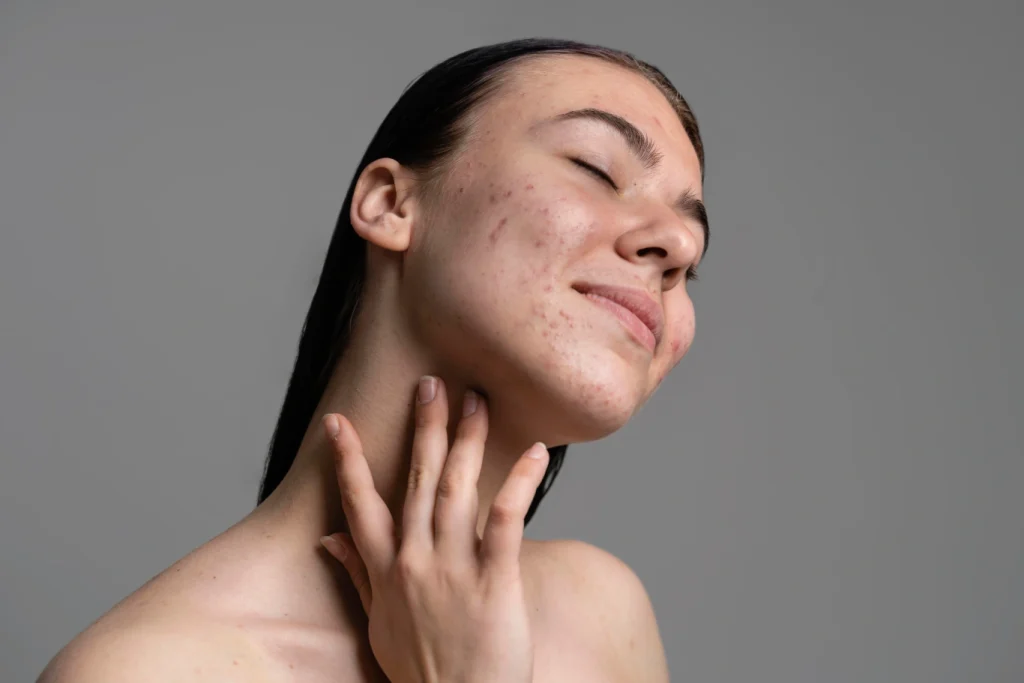Many new patients arrive at Genomed unsure whether they have PIH (post-inflammatory hyperpigmentation), true acne scars, or both. In Dubai’s high-UV climate—and across Fitzpatrick IV–VI tones—getting the diagnosis right determines everything: the sequence of care, the devices we pick, and how we prevent pigment rebound. PIH is mainly a color problem; acne scars are structure problems. Pigment is treated with Chemical Peels/Medical Facials, while structural scars need collagen remodeling via Microneedling (Biosome Skin Pen) ± PRP and RF Facial Contouring (VFR). (Deeper dives and citations appear where relevant.)
How to spot PIH vs a scar (quick check)
PIH: flat brown/grey marks; smooth to the touch; darkens with sun; gradually fades with pigment control (peels, sunscreen).
Scar: indented or raised texture that doesn’t fade on its own; needs collagen remodeling (microneedling/RF).
Most people have both—pigment overlaying texture—so we often alternate pigment-safe peels/facials with needling-based remodeling in a plan tailored to your tone and tolerance.
Scar type 1 — Rolling scars (soft edges, wavy skin)
How it looks: broad, shallow depressions with soft edges; shadows shift with side-lighting.
Primary goal: smooth the dermal “waves” by reorganizing collagen.
Best at Genomed (Fitz IV–VI-safe):
Microneedling (Biosome Skin Pen): first-line for rolling scars; multiple sessions (typically 3–5) improve texture with a strong safety profile in skin of color.
Microneedling + PRP: enhances clinical improvement and satisfaction vs microneedling alone without more serious AEs; we use PRP as glide and post-infusion.
RF Facial Contouring (VFR): consider when rolling scars coexist with early laxity; RF adds controlled dermal heat for tightening plus remodeling, with low rates of dyspigmentation in skin of color when parameters are tailored.
Support:
Chemical Peels / Medical Facials: placed between needling sessions to reduce PIH and brighten tone (lactic/mandelic favored).
Scar type 2 — Boxcar scars (wider bases, sharper walls)
How it looks: round/oval depressions with clearly defined edges; depth varies.
Primary goal: soften edges and build collagen at the base.
Best at Genomed:
Microneedling (Biosome Skin Pen): systematic, depth-mapped passes to stimulate uniform remodeling over 3–5 sessions.
Microneedling + PRP: improves outcomes vs needling alone; helpful for stubborn boxcar areas.
RF Facial Contouring (VFR): when skin thickness or mild laxity suggests benefit from thermal tightening alongside remodeling; evidence supports acne-scar improvement with RFM.
Support:
Chemical Peels / Medical Facials: good for color correction and surface refinement, but peels alone won’t fix deeper boxcar pits.
Scar type 3 — Ice-pick scars (narrow, deep tracks)
How it looks: small, pinpoint openings that taper deep into the dermis—hard to fill with collagen alone.
Primary goal: focal remodeling at the opening and tract.
Best at Genomed (our approach):
Microneedling (Biosome Skin Pen) ± PRP: improves overall texture; softens surrounding skin so ice-picks are less stark.
Targeted techniques (case-by-case): some ice-picks respond best to focal chemical reconstruction (e.g., TCA-CROSS) performed by experienced clinicians; evidence supports CROSS for ice-picks, including in darker skin types, but it requires careful patient selection and aftercare to minimize PIH.
Support:
Chemical Peels / Medical Facials: manage PIH and texture around the scars but won’t close deep tracts on their own.
Where Chemical Peels/Medical Facials fit (and where they don’t)
Do: fade PIH, smooth superficial roughness, and prep skin between remodeling sessions—especially with lactic/mandelic or other pigment-safe blends in Fitz IV–VI.
Don’t: rely on peels alone to correct deep indentations; medium/deep peels can help select scars but carry higher dyschromia risk in darker tones and are used cautiously.
Why we “alternate, don’t stack” for pigment-prone skin
To limit cumulative inflammation (and PIH risk) we typically alternate remodeling sessions (Microneedling / RF VFR) with Chemical Peels/Medical Facials 10–14 days apart, rather than doing everything on the same day. This maintains momentum on texture + tone with lower irritation.
How many sessions? What to expect
Microneedling series: commonly 3–5 sessions at 4–6-week intervals; collagen remodeling builds gradually over months.
RF Microneedling (VFR): similar cadence (3–5 sessions), with subtle tightening benefits alongside texture change; maintenance can be 6–12 months.
Peels/Facials: often scheduled between sessions; pigment clearance frequently needs a series rather than a single peel.
Dubai-specific safety notes (Fitz IV–VI)
Sun protection is non-negotiable: broad-spectrum SPF (UVA/UVB; ideally visible-light protection with iron oxides) + hats/shade; reapply outdoors about every 2 hours. This is central to PIH prevention.
RF microneedling & standard microneedling show low dyspigmentation risk in skin of color when parameters and aftercare are right.
Cynosure Elite+ (Laser Hair Removal): an outstanding LHR platform—but not our first-line choice for acne scars or PIH; for pigment/texture we prioritize peels, microneedling, PRP, and RF VFR.
The Genomed treatment matrix (quick reference)
Rolling: Microneedling (Biosome Skin Pen) → MN+PRP → RF VFR if laxity present | Peels/Facials between sessions
Boxcar: Microneedling → MN+PRP → RF VFR as needed | Peels/Facials assist tone
Ice-pick: Microneedling to improve context; consider focal techniques (e.g., TCA-CROSS) after assessment | Peels/Facials for PIH
